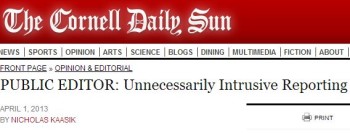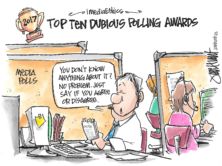
(Credit: Cornell Daily Sun, screenshot)
A student dies of natural causes and the school newspaper gets a picture of his housemate’s reaction. Should the paper print that?
The public editor for Cornell University student newspaper the Cornell Daily Sun, Nicholas Kaasik, says no. Kaasik slammed the paper for publishing the “sensationalist” photo of a student’s emotional reaction.
The photo, which was used to accompany coverage of the February death of student Joe Quandt, had no “significant journalistic value” and instead was more “paparazzi-like,” Kaasik argued.
Despite reader complaints about the photo, the newspaper said it wouldn’t unpublish the image. In a letter from the editors, the paper argued the photo helped visualize “the scope of this otherwise unimaginable tragedy.” The paper wrote:
“The image captures the magnitude of this tragedy in a way that the clinical, impersonal language required by a news article often cannot. When looking back on The Sun’s report of Quandt’s death, the photo of his grieving housemates will convey to a removed party the scope of this otherwise unimaginable tragedy.”
Sun editor-in-chief Rebecca Harris responded to Kaasik’s evaluation of the paper’s actions, noting that the paper doesn’t regard itself as limited to the university campus.
“We highly value the opinion of Nick Kaasick [sic], The Sun‘s Public Editor, whose job it is to critique our editorial decisions and the way in which we choose to cover the news,” Harris wrote to iMediaEthics.
“We do disagree with Nick’s assessment of The Sun as solely a community newspaper,” she continued. “While our scope is local and our staff is uniquely connected to our college readership, The Sun is still an independent news outlet whose primary charge is to inform the public.”
Regardless of that defense, public editor Kaasik found that the photo broke the paper’s own standards in publishing photos with its coverage of student deaths.
Does Publication of the Photo Break The Sun’s Standards? Kaasik Said Yes
The Sun published newly drafted standards, The Protocol for Reporting on Student Deaths, in response to reader complaints over the photo. They were established, the page explains, to “help The Sun avoid overwhelming or unnecessarily upsetting sources” when reporting on student deaths.
The Sun’s editor Harris, told iMediaEthics by email that the newspaper’s managing editor and others set up the protocol “in the week following Joe Quandt’s death,” directly in response to complaints over the photo of Quandt’s roommates.
According to Harris, “most of the complaints, to the best of our knowledge” were from Quandt’s friends.
Harris explained that the newspaper’s managing editor and “other senior leadership at the paper” developed the guidelines based on “standards outlined in Associated Press policies, as well as our own previous experiences with covering tragic or sensitive events.” The guidelines include:
- The appointment of one staff member, who has no relation to “the student or micro-community that is involved” in a student death to contact sources and take charge in reporting.
- That reporter is advised to contact sources by email first to give source the chance to avoid catching sources off-guard.
- The guidelines also instruct reporters not to text sources or leave voicemails about the death in case the source didn’t know yet.
- The Sun’s guidelines advise not naming the student unless it knows the student’s family was already told
- Students should be cautious in reporting on suicides.
- The photography section of the guidelines requires sensitivity. “The Sun should be careful to balance the concerns of subjects portrayed in photographs with the journalistic value of the photos,” the guidelines read. “The Sun should also ensure that it shows due concern to subjects of photographs both before and after publication.”
Did Quandt Reporting Meet these Guidelines?
Public editor Kaasik concluded that the photo in question didn’t meet those standards.
“While this protocol seems appropriate in balancing the sensitivity of the issue with the interest in covering the story, The Sun’s decision to publish this photo fails the balancing test outlined in the ‘Photographs’ portion of protocol,” Kaasik wrote.
But, he found “This balancing test, given the circumstances surrounding Quandt’s death, should have resulted in the opposite action,” meaning the paper should have unpublished the photo upon receiving complaints.
Because Quandt died of natural causes, Kaasik argued the photo of the “grieving” student is different from photos of reactions to the Sandy Hook shootings.
iMediaEthics has written to Kaasik for more information about his role as the paper’s public editor. We’ll update with any responses.






